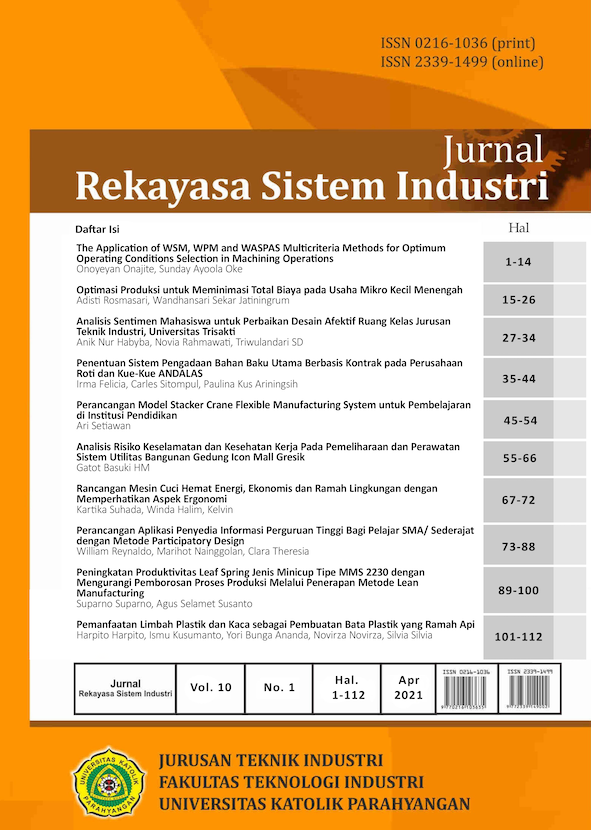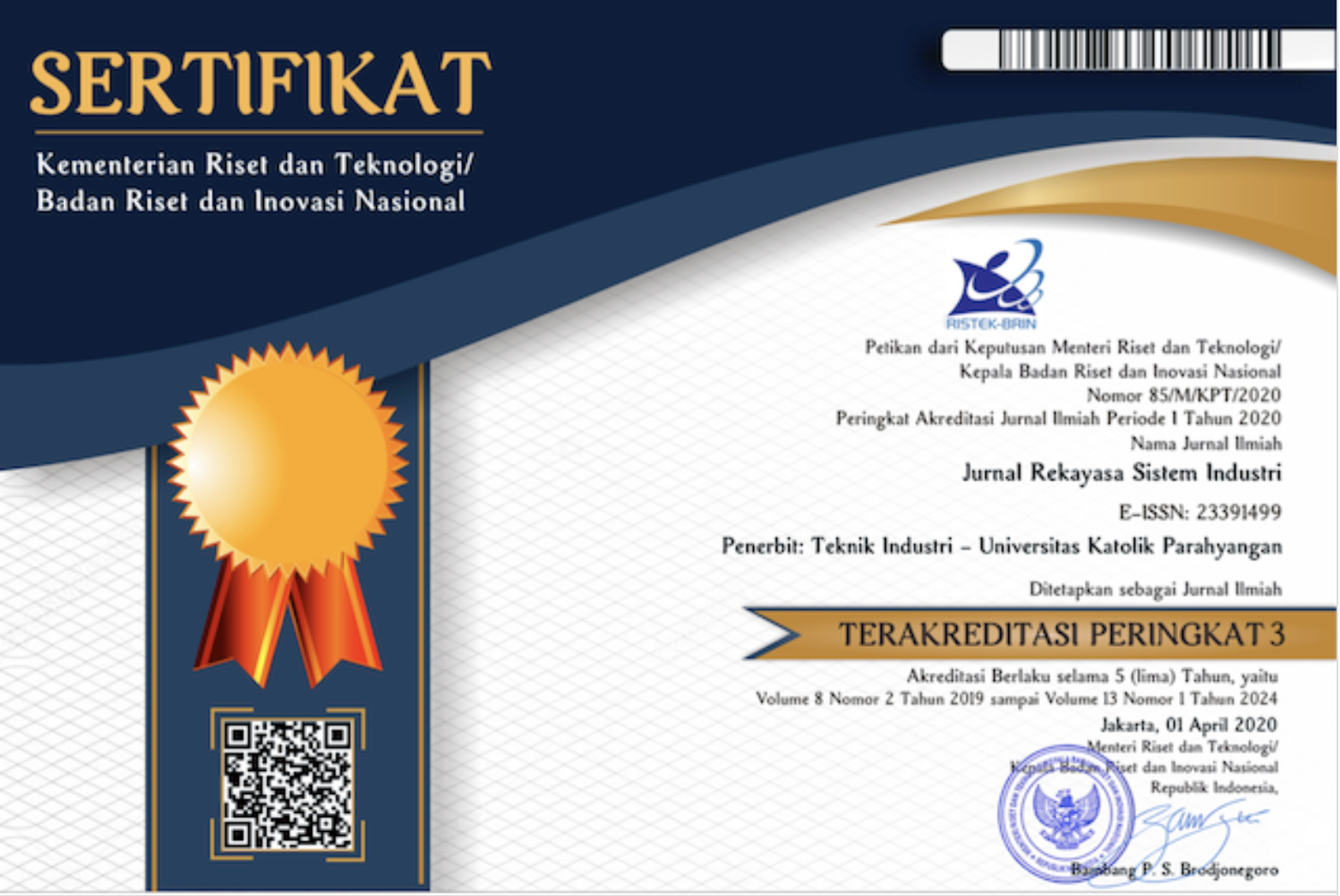Analisis Sentimen Mahasiswa untuk Perbaikan Desain Afektif Ruang Kelas Jurusan Teknik Industri, Universitas Trisakti
DOI:
https://doi.org/10.26593/jrsi.v10i1.4319.27-34Abstrak
Improving the affective classroom design is essential to maximize student performance and learning achievement. The comfort and performance achievement of Trisakti University Industrial Engineering students are influenced by the affective design of classrooms. This study aimed to use sentiment analysis in the classification of students’ perceptions of the affective classroom design. Student sentiment classification is done using a Support Vector Machine (SVM). The questionnaire analysis results also showed perceptions about the subjects that were considered the most difficult (statistics). The classrooms had a positive sentiment: FGTSC, a sample for the next stage of classroom design formulation. The results show what impressions and things the students consider in choosing the FGTSC class. Some examples of the dominant kansei word are “comfortable,” this shows that students really care about the comfort of a classroom in the learning process. The word kansei for the design concept was collected from students' perceptions of the “positive” label. Design elements that need to be improved include equipment that is less comfortable to use, less lighting, walls with graffiti and uncomfortable seating. The classification results using three SVM types Kernel linear, radial and polynomial obtained linear have the best accuracy value (76%). These results indicate that the classification of student sentiment has the maximum results with SVM linear kernel (dot) type. This method will be used in classifying student sentiment on the results of improving classroom design.
Referensi
Ahmad, M., Aftab, S., & Ali, I. (2017). Sentiment Analysis of Tweets using SVM. International Journal of Computer Applications, 177(5), 25–29. https://doi.org/10.5120/ijca2017915758
Akhtar, N., Zubair, N., Kumar, A., & Ahmad, T. (2017). Aspect based Sentiment Oriented Summarization of Hotel Reviews. Procedia Computer Science. https://doi.org/10.1016/j.procs.2017.09.115
Altrabsheh, N., Cocea, M., & Fallahkhair, S. (2014). Learning sentiment from students’ feedback for real-time interventions in classrooms. Lecture Notes in Computer Science (Including Subseries Lecture Notes in Artificial Intelligence and Lecture Notes in Bioinformatics). https://doi.org/10.1007/978-3-319-11298-5_5
Caldwell, B. S. (1992). Human factors and educational quality. Proceedings of the Human Factors Society, 1, 548–552. https://doi.org/10.1177/154193129203600603
Castilla, N., Llinares, C., Bravo, J. M., & Blanca, V. (2017). Subjective assessment of university classroom environment. Building and Environment, 122, 72–81. https://doi.org/10.1016/j.buildenv.2017.06.004
Gangrade, S., Shrivastava, N., & Gangrade, J. (2019). Instagram Sentiment Analysis: Opinion Mining. SSRN Electronic Journal. https://doi.org/10.2139/ssrn.3372757
Liu, B. (2015). Sentiment analysis: Mining opinions, sentiments, and emotions. In Sentiment Analysis: Mining Opinions, Sentiments, and Emotions. https://doi.org/10.1017/CBO9781139084789
Medhat, W., Hassan, A., & Korashy, H. (2014). Sentiment analysis algorithms and applications: A survey. Ain Shams Engineering Journal. https://doi.org/10.1016/j.asej.2014.04.011
Murnawan, M. (2017). Pemanfaatan Analisis Sentimen Untuk Pemeringkatan Popularitas Tujuan Wisata. Jurnal Penelitian Pos Dan Informatika, 7(2), 109. https://doi.org/10.17933/jppi.2017.070203
Musicant, D. R., Kumar, V., & Ozgur, A. (2003). Optimizing F-Measure with Support Vector Machines. Sixteenth International Florida Artificial Intelligence Research Society Conference (Flairs).
Nagamachi, M. (2011). Kansei/Affective Engineering. CRP Press, Taylor & Francis Group.
Nagamachi, M., & Lokman, A. M. (2016). Innovations of Kansei Engineering. In Innovations of Kansei Engineering. https://doi.org/10.1201/ebk1439818664
Pong-inwong, C., & Songpan, W. (2019). Sentiment analysis in teaching evaluations using sentiment phrase pattern matching (SPPM) based on association mining. International Journal of Machine Learning and Cybernetics, 10(8), 2177–2186. https://doi.org/10.1007/s13042-018-0800-2
Qaiser, S., & Ali, R. (2018). Text Mining: Use of TF-IDF to Examine the Relevance of Words to Documents. International Journal of Computer Applications. https://doi.org/10.5120/ijca2018917395
Ramli, N. H., Ahmad, S., & Masri, M. H. (2013). Improving the Classroom Physical Environment: Classroom Users’ Perception. Procedia - Social and Behavioral Sciences, 101, 221–229. https://doi.org/10.1016/j.sbspro.2013.07.195
Sari, F. V., & Wibowo, A. (2019). Analisis Sentimen Pelanggan Toko Online Jd. Id Menggunakan Metode Naïve Bayes Classifier Berbasis Konversi Ikon Emosi. Simetris: Jurnal Teknik Mesin, Elektro Dan Ilmu Komputer, 2(2), 681–686.
Smith, T. (2001). Educational ergonomics: educational design and educational performance. Proceedings of the XVth Triennial Congress of The. http://citeseerx.ist.psu.edu/viewdoc/download?doi=10.1.1.136.733&rep=rep1&type=pdf
Suyanto. (2019). Data Mining untuk Klasifikasi dan Klasterisasi Data. Informatika Bandung.
Tessem, B., Bjørnestad, S., Chen, W., & Nyre, L. (2015). Word cloud visualisation of locative information. Journal of Location Based Services, 9(4), 254–272. https://doi.org/10.1080/17489725.2015.1118566
Ullah, M. A., Marium, S. M., Begum, S. A., & Dipa, N. S. (2020). An algorithm and method for sentiment analysis using the text and emoticon. ICT Express, Article in. https://doi.org/https://doi.org/10.1016/j.icte.2020.07.003
Ushada, M., Kusuma Aji, G., Okayama, T., & Khidir, M. (2018). SME Worker Affective (SWA) index based on environmental ergonomics. IOP Conference Series: Materials Science and Engineering, 337(1). https://doi.org/10.1088/1757-899X/337/1/012037
Ushada, Mirwan, Suyantohadi, A., Khuriyati, N., & Okayama, T. (2017). Identification of environmental ergonomics control system for Indonesian SMEs. 2017 3rd International Conference on Control, Automation and Robotics, ICCAR 2017, 453–456. https://doi.org/10.1109/ICCAR.2017.7942737













